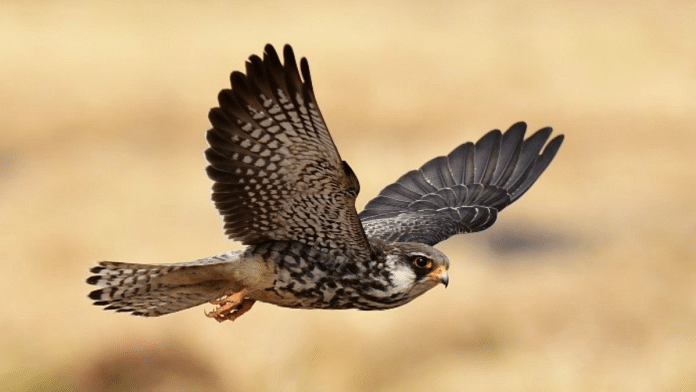New Delhi: The world is watching the Amur falcons. The humble raptor, which was once being massacred by the hundreds in Nagaland, now has its very own fanbase — a faction of the internet that is glued to the travails of their journey. Three birds, which are being monitored using a satellite tracker, have travelled across geographies — forests, continents, and oceans.
Apapang, Alang, and Ahu have travelled from the jungles of Manipur to the arid grasslands of the Horn of Africa in a miraculous five days. Apapang made the journey in one go, without a single layover or detour. This translates to roughly 6,100 kms in six days and eight hours. Alang stopped over in Telangana and in Maharashtra. While Ahu, a female bird, took a “relatively shorter route” to Somalia.
Snippets of their journey have been shared on X by IAS officer Supriya Sahu. The tracking and mapping of the raptors is being undertaken by the Wildlife Institute of India (WII), as part of the Manipur Amur Falcon Tracking Project.
“For those struck by the magic of Amurs! Apapang makes it across the Arabian Sea with ease and enters the Horn of Africa, specifically Somalia. Apapang, being an adult male, has definitely done this oceanic crossing multiple times before. Apapang has now done nearly 5400 km, and it has taken him 5 days and 15 hours,” wrote Sahu on X, one of her several updates on the progress of the Amur falcons.
An incredible journey
Reports suggest that the speed and tenacity showcased by the Amur falcons — who are small in size and have been designated a species of “least concern” owing to their numbers — have left both wildlife scientists and people at large spellbound.
The migratory pattern followed by the Amur falcon encompasses much of the planet. As winter sets in, they abandon their regular haunts of Russia, China, and Japan, and begin the trek to Africa. Situated in between is a special stop-over: the Northeast region of India.
“For centuries, birds from across the world converge in Nagaland and Manipur to rest and refuel before heading off to South Africa again,” Suresh Kumar, scientist at WII, had earlier told ThePrint. “And this stopover is important because their journey after this is most often unbroken. So it’s the last stop they have before they reach Africa”.
Also read: SC removes a roadblock to the Mekedatu dam. Why is this Karnataka’s dream project?
Killing to conservation
But behind the adulation and the tales of awe is a story with murkier origins. Before they turned into starlets, the Amur falcons were killed on the regular. But here too, lies a remarkable tale. In 2009, a social media post by Joyce Tan, who was visiting Nagaland from Singapore, documented the butchering of Amur falcons, who were purportedly being “harvested in sackfuls.”
This death-knell was heard by conservationists, who began working tirelessly to erase this culture of killing Amur falcons. Photographs depict what this migration is like. The sky is dotted with these birds. For local people in Nagaland’s Pangti village, they fell like “manna from heaven,” according to a report in Frontline.
Other than the imposition of bans and a media firestorm, conservationists engaged the local people in continuous dialogue.
“A village could not depend on 1 month of killing, even if it was lucrative, to sustain the remaining 11 months,” conservationist Bano Haralu told Frontline. “Conservation itself will bring you benefits eventually, we told the villagers. We said we will guarantee that the stopping of the killings makes news in the same way that the hunting made news. It would be a legacy that would last forever.”
In 2013, three birds — Pangti, Wokha and Naga — were satellite-tagged for the first time. The naming of the birds marked a new dawn, instilling a sense of ownership and responsibility among local communities, who also became conservationists in their own right.
Today, the Amur falcon is the talk of the town — but one chapter of its story begins in mass slaughter; a reminder of the importance of community-driven conservation.
(Edited by Aamaan Alam Khan)






